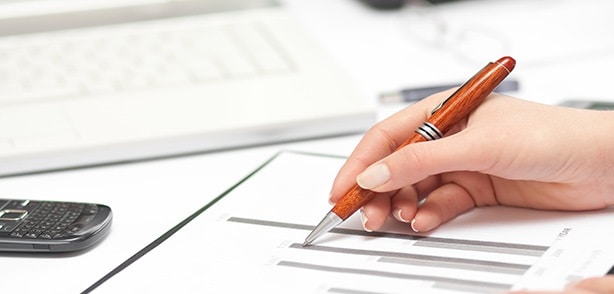May 17, 2021
The Ultimate Guide to SBA Loan Forms
In fact, the Small Business Administration (SBA) requires you to fill out and sign numerous types of SBA loan forms.
At a minimum, for a standard 7(a) SBA loan, you’ll need to complete Form 1919 and Form 148 or 148L. However, you may also be required to complete up to nine other forms.
You’ll also be asked for many other documents such as your tax returns and financial statements. If you need help gathering your financial and tax information, read our post about the required documentation needed when applying for a loan.
For the purposes of this article, though, we’re going to guide you through what forms are needed for a SBA loan program.
To simplify things, this article is divided into two sections. The first section lists the forms required on all SBA(7a) loans. The second section lists forms that are commonly—but not always—required.


The Minimum: Form 1919,148, 355 and Closing Forms
You only need to complete the forms in this section if you meet the following criteria:- You answer no to questions 18 and 19 on Form 1919
- Your lender doesn’t require a Form 413
- Your loan doesn’t involve a construction project valued at more than $10,000
1. SBA Form 1919, Borrower Information Form
You, anyone who owns 20 percent or more of the company, and any employee hired to manage daily operations must fill out this form. Its purpose is to collect information such as:- Information about the small business owners
- The loan request
- The business's level of indebtedness
- Current or previous government financing.
2. SBA Form 148 or 148L, Personal Guarantee
To obtain any standard SBA loan, you and anyone who owns 20 percent or more of your business must provide a personal guarantee. SBA Forms 148 and 148L are the forms SBA lenders use to document this guarantee. The difference between the forms is that Form 148 documents an unconditional, unlimited guarantee while Form 148L documents a conditional, limited guarantee. Unlike Form 1919, Form 148 and 148L are signed when you close on a loan. Therefore, if you’re just starting the application process, you won't have to complete this form just yet.3. SBA Form 160, Board of Directors Resolution
If your business has a board of directors, you’ll need to document that your board has agreed and has the authority to take out the loan. You, along with any other company officers named will need to sign this document at closing.4. SBA Form 355, Small Business Size Determination
Only small businesses are eligible for SBA loans, so the SBA must confirm that your business conforms to its size limits. For this verification, they use Form 355. On the form, you’ll need to provide information to help the SBA determine if your company qualifies as a small business. However, if you’re applying for the SBA’s Small Business Investment Companies (SBIC) Program, you’ll fill out Form 480 instead. Note: In certain cases, you will need to sign disclosures other than the forms in this section. Therefore, if you have any questions about any additional disclosures you’ve been asked to sign, you should contact your lender directly.
Others Commonly Required Documents: Forms 912, 413, 159, and 601
The following forms aren’t always required in order to receive an SBA loan but they’re still quite common. Whether you need them or not will depend on your business's financial situation and your lender’s preferences.1. SBA Form 912, Statement of Personal History
As of this writing, Form 912 is only required if you answer yes to questions 18 or 19 on Form 1919. This form is called the Statement of Personal History and the SBA uses it to make a character and credibility eligibility decision. Any owners of your company who answered yes to questions 18 or 19 on Form 1919 must fill out Form 912.2. SBA Form 413, Personal Financial Statement
SBA Form 413 asks for information about your assets and liabilities. It’s used to assess your repayment ability and creditworthiness. The SBA doesn’t require this form, but they provide it for lenders who want to use it. Therefore, whether you need to fill this out depends on your lender and if they want to learn more about your business plan, personal credit score, and business credit score prior to providing you with financing.3. SBA Form 159, Fee Disclosure and Compensation Agreement
If you hired an agent to help you obtain your SBA 7(a) or 504 loan, you’ll need to complete SBA Form 159. This form requires information to identify the Agent and the compensation paid to the Agent. You as the applicant, your lender, and any Agent(s) must sign this document in order to finalize the loan process..4. SBA Form 601, Agreement of Compliance
If your SBA loan involves construction valued at more than $10,000, you and the construction contractor must fill out Form 601. This form is needed at closing to show that the contractor is not engaging in discriminatory hiring practices.5. IRS Form 4506-T
Although it isn't technically an SBA form, you may be asked to provide an IRS Form 4506-T. This is a request for tax transcripts and it’s required if your business lender uses your income tax returns when making their credit decision.Conclusion: Take Time to Complete SBA Loan Forms
As you can see, there are many forms involved in the SBA’s loan application and closing processes. Due to this, it’s a good idea to familiarize yourself with the forms you’ll likely need to complete prior to applying. While it’s true that your lender should let you know what’s needed, knowing ahead of time allows you to prepare. By coming prepared for the application process, you can receive financing at a faster pace. In addition, remember to assess other loan options prior to starting the application process. At Fora Financial, we strive to make our application process as quick and seamless as possible. To get more information about how our financing process works, click the link below for a free quote.